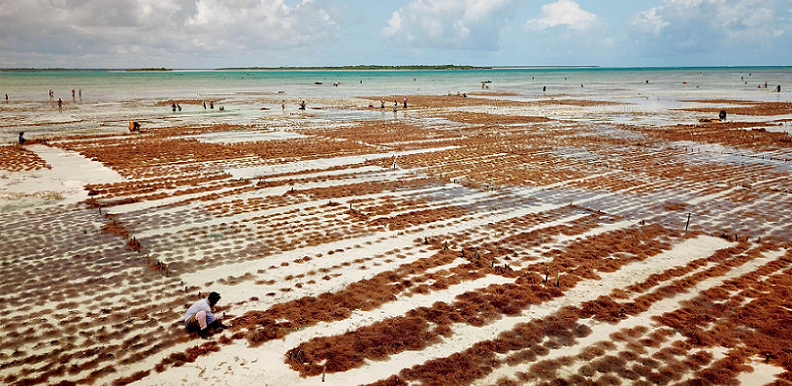In the ongoing quest for sustainable living, we’re all familiar with the usual suspects: solar power, electric cars, recycling, and more. But there’s a lesser-known hero emerging from the ocean’s depths—seaweed. This marine plant, used in culinary traditions around the world, is making waves as a potential powerhouse of sustainable nutrition.
Here we explore how this humble ocean vegetable is not only brimming with nutrients that benefit our bodies, but also plays a pivotal role in environmental conservation, with a farming process that can contribute to carbon capture and ocean health.
Introduction to Seaweed as a Food Source
Sea, sun, and surf may be the first things that come to mind when we think of seaweed, but there’s much more to this marine vegetable than meets the eye. Long before it was regarded as a superfood in the western world, seaweed had been harvested and consumed by coastal communities across the globe.
Overview of Seaweed and its Importance
Seaweed, marine algae that grows along the coasts of the world’s oceans, is an extraordinarily versatile organism. Not only does it provide essential habitat for many marine species, it also holds untapped potential for contributing to our health and wellbeing.
Seaweeds are broadly classified into three types based on their color – green, brown, and red, each with its unique attributes and benefits. They are the oceans’ forests, hosting a rich biodiversity and contributing substantially to the planet’s photosynthesis, playing a critical role in Earth’s carbon cycle.
From a nutritional standpoint, seaweed packs a punch. It’s a rich source of vitamins, minerals, and fiber, and some types even boast high-quality protein content. Not to mention, it’s low in calories, making it an excellent addition to any diet.
Historical Usage of Seaweed as Food
Seaweed isn’t a newfangled health trend; rather, it has a long history of use as a food source. Cultures around the world, particularly those in East Asia, have been incorporating seaweed into their diets for centuries.
In Japan, seaweed has been consumed for over 2,000 years and is integral to their cuisine, appearing in well-known dishes such as sushi, miso soup, and nori rolls. China and Korea, too, have a history of seaweed consumption that dates back hundreds of years. The Irish have been eating seaweed in the form of dulse and carrageenan, and the coastal communities of the Pacific Northwest traditionally harvested kelp and other seaweeds.

Nutritional Profile of Seaweed
With a rich history of seaweed consumption around the world, one may wonder what makes these marine plants such a valuable addition to our diets. It turns out, seaweeds are much more than just marine flora. Their nutrient-dense profile makes them a potential superfood, offering a range of benefits that contribute to overall health and wellbeing.
Vitamins and Minerals Found in Seaweed
One of the standout features of seaweed is its remarkable content of vitamins and minerals. Many varieties of seaweed are high in vitamins like vitamin K, which plays a crucial role in blood clotting and bone health, vitamin A, which is important for healthy skin and vision, and several B vitamins, including B12, which is essential for nerve function and the production of red blood cells.
When it comes to minerals, seaweed truly shines. It’s particularly rich in iodine, a mineral vital for proper thyroid function, and often hard to come by in other foods. Seaweed also contains significant amounts of calcium, necessary for strong bones and teeth, and magnesium, which plays a role in over 300 enzymatic reactions in the body, including muscle and nerve function [1].
Protein Content and Other Essential Nutrients
Believe it or not, certain varieties of seaweed, such as spirulina and chlorella, are good sources of protein, containing all the essential amino acids that our bodies can’t produce on their own. While seaweed may not replace your main protein source, it certainly can boost your protein intake, especially if you follow a vegetarian or vegan diet.
Seaweeds also offer other valuable nutrients like dietary fiber and omega-3 fatty acids. Dietary fiber aids in digestion, helps control blood sugar, and supports heart health by helping to lower cholesterol levels. Omega-3 fatty acids, particularly those found in seaweed, are associated with numerous health benefits, including reducing inflammation and supporting brain health.
Benefits of Seaweed for Digestive Health
Beyond the vital vitamins, minerals, and other nutrients, seaweed can also benefit our digestive health. Many types of seaweed are rich in soluble fiber, including a unique type known as alginate. This fiber adds bulk to the diet and can help you feel full, aiding in weight management [2].
Additionally, seaweed’s soluble fiber has prebiotic effects, helping to nourish the beneficial bacteria in our gut. A healthy gut microbiome is associated with improved digestion and a stronger immune system, and may even impact mental health.

Environmental Impact of Seaweed Farming
While the nutritional benefits of seaweed are indeed impressive, its true potential lies in how it interacts with our planet. In our pursuit for sustainable food sources, seaweed presents a compelling case. Not only is it a resilient crop that requires no freshwater, arable land, or fertilizers, it also provides ecological benefits that reach far beyond its role as food.
Sustainability of Seaweed Farming
Seaweed farming is a low-impact form of food production. Unlike land-based agriculture, it doesn’t require deforestation, or the use of freshwater resources or synthetic fertilizers – elements that contribute to climate change and biodiversity loss. Instead, seaweeds grow naturally in marine environments, absorbing nutrients directly from seawater and sunlight to grow.
Additionally, seaweed farms can function alongside existing marine activities such as fisheries, creating multi-use spaces in our oceans. They can even contribute to improving local water quality, as seaweeds absorb excess nutrients, like nitrogen and phosphorous, that run off from land into our oceans.
The Role of Seaweed in Carbon Capture and Ocean Health
Seaweeds are remarkable carbon-capture organisms. They absorb carbon dioxide from the atmosphere for photosynthesis, much like trees do on land, but at a significantly faster rate. Some studies suggest that large-scale seaweed farming could play a role in mitigating the impacts of climate change by sequestering large amounts of carbon dioxide.
In addition to carbon sequestration, seaweeds also help combat ocean acidification, a process driven by the ocean’s absorption of carbon dioxide from the atmosphere. As seaweed absorbs carbon dioxide, it helps restore the ocean’s pH balance, creating healthier environments for other marine life [3].
Comparison with Traditional Land Farming
When compared with traditional land farming, the benefits of seaweed farming become even more apparent. Land-based agriculture often depletes soil nutrients over time, requires significant inputs like water and fertilizers, and is a major contributor to greenhouse gas emissions. It also requires substantial space, often resulting in deforestation and loss of biodiversity.
Seaweed farming, on the other hand, can be implemented with minimal environmental impact, and actually provides restorative effects on marine ecosystems. The no-land, no-freshwater, and no-fertilizer needs of seaweed farming make it a truly sustainable form of agriculture.
Current State of Seaweed Farming
Given the extensive benefits seaweed offers to our health and the environment, it’s unsurprising that its farming has seen considerable growth in recent years. Today, the seaweed industry is a global enterprise, with certain countries leading the charge and some interesting trends beginning to emerge. Let’s dive into the current state of seaweed farming.
Leading Countries in Seaweed Production
When it comes to seaweed production, East Asia is at the forefront. China, Indonesia, and the Philippines are the largest producers, collectively accounting for over 80% of the world’s seaweed supply. In these countries, seaweed is an important part of the culture and diet, and is used in a variety of dishes [4].
South Korea and Japan are also significant contributors to global seaweed production, primarily producing Nori and Wakame varieties. Apart from these, there’s an increasing interest in seaweed farming in other parts of the world, including North America, Europe, and Australia, recognizing its potential for local economies and sustainable agriculture.
Innovations and Techniques in Seaweed Farming
The growth of seaweed farming has also led to many innovations in the sector. Today, farming techniques are far more advanced than the traditional methods of wild harvesting or growing seaweed close to the shore.
Now, with the advent of technologies like long-line systems, farmers can grow seaweed in deeper waters, thereby increasing production without impacting coastal areas. Such advancements not only improve yield but also minimize the potential impact on local ecosystems.
Researchers are also exploring methods to optimize growth rates and improve the quality of seaweed, using selective breeding and improved cultivation practices. The focus is not just on increasing volume but also enhancing the nutritional and environmental benefits of seaweed.
Challenges and Opportunities
Despite the positive outlook, there are challenges to address. Issues such as the risk of diseases, the impact of climate change on seaweed growth, and the need for improved farming and processing techniques must be tackled to ensure the seaweed sustainability and scalability of the industry.
At the same time, there are ample opportunities for growth. As awareness of seaweed’s health and environmental benefits continues to spread, demand for seaweed-based products is expected to rise. Furthermore, seaweed has potential applications beyond food, including in biofuels, fertilizers, and pharmaceuticals, suggesting a wide range of opportunities for industry expansion.

The Future of Seaweed as a Sustainable Food Source
As we’ve seen, seaweed carries with it a wave of potential. It nourishes our bodies, absorbs carbon dioxide, and is cultivated in a way that has minimal impact on the environment. With a growing global population and increasing concerns about climate change, sustainable and nutrient-rich food sources like seaweed will undoubtedly play a pivotal role in the future of our food systems.
Increasing Global Demand for Seaweed
The demand for seaweed as food is growing worldwide. The western world is waking up to the nutritional benefits and versatility of seaweed, incorporating it into everyday foods in new and exciting ways – from snacks and salads to smoothies and even baked goods [5].
Beyond individual consumption, the food industry is also recognizing seaweed’s potential. It’s increasingly used as an ingredient in plant-based products, given its ability to impart a savory, umami flavor. Moreover, the food industry is using seaweed extracts as natural thickeners and stabilizers, in line with the trend of clean and sustainable ingredients.
Expansion of Sustainable Seaweed Farming Practices
As the demand for seaweed grows, sustainable farming practices will become increasingly important. Innovations in farming techniques and technologies, as well as strategies to prevent disease and improve yield, will be key to ensuring the sustainable growth of the industry.
To fully realize seaweed’s environmental potential, efforts should also focus on increasing the use of seaweed farming for carbon sequestration and water purification. Regulations and incentives might be needed to support such practices and to ensure the long-term sustainability of the industry.
Increased Research and Development
Lastly, continued research and development will be crucial in the future of seaweed as a sustainable food source. This includes not only advancements in farming and processing but also research into the nutritional benefits of different seaweed varieties.
There’s still a lot to uncover about this marine superfood. Every variety of seaweed has its unique nutritional profile and potential health benefits. Ongoing research will allow us to better understand these benefits, tailor seaweed products to specific health needs, and potentially discover new applications for seaweed in food and beyond.
References
[1] Seaweed Aquaculture
[2] Ensuring the Sustainable Future of the Rapidly Expanding Global Seaweed Aquaculture Industry – A Vision
[3] A seaweed aquaculture imperative to meet global sustainability targets
[4] Sustainability — Farming seaweed could help bolster food security
[5] The Ocean Farmers Trying to Save the World With Seaweed


